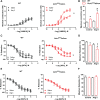Endothelial Cell Tetrahydrobiopterin Modulates Sensitivity to Ang (Angiotensin) II-Induced Vascular Remodeling, Blood Pressure, and Abdominal Aortic Aneurysm
- PMID: 29844152
- PMCID: PMC6012043
- DOI: 10.1161/HYPERTENSIONAHA.118.11144
Endothelial Cell Tetrahydrobiopterin Modulates Sensitivity to Ang (Angiotensin) II-Induced Vascular Remodeling, Blood Pressure, and Abdominal Aortic Aneurysm
Abstract
GTPCH (GTP cyclohydrolase 1, encoded by Gch1) is required for the synthesis of tetrahydrobiopterin; a critical regulator of endothelial NO synthase function. We have previously shown that mice with selective loss of Gch1 in endothelial cells have mild vascular dysfunction, but the consequences of endothelial cell tetrahydrobiopterin deficiency in vascular disease pathogenesis are unknown. We investigated the pathological consequence of Ang (angiotensin) II infusion in endothelial cell Gch1 deficient (Gch1fl/fl Tie2cre) mice. Ang II (0.4 mg/kg per day, delivered by osmotic minipump) caused a significant decrease in circulating tetrahydrobiopterin levels in Gch1fl/fl Tie2cre mice and a significant increase in the Nω-nitro-L-arginine methyl ester inhabitable production of H2O2 in the aorta. Chronic treatment with this subpressor dose of Ang II resulted in a significant increase in blood pressure only in Gch1fl/fl Tie2cre mice. This finding was mirrored with acute administration of Ang II, where increased sensitivity to Ang II was observed at both pressor and subpressor doses. Chronic Ang II infusion in Gch1fl/fl Tie2ce mice resulted in vascular dysfunction in resistance mesenteric arteries with an enhanced constrictor and decreased dilator response and medial hypertrophy. Altered vascular remodeling was also observed in the aorta with an increase in the incidence of abdominal aortic aneurysm formation in Gch1fl/fl Tie2ce mice. These findings indicate a specific requirement for endothelial cell tetrahydrobiopterin in modulating the hemodynamic and structural changes induced by Ang II, through modulation of blood pressure, structural changes in resistance vessels, and aneurysm formation in the aorta.
Keywords: angiotensin II; aorta; blood pressure; endothelial cells; vascular remodeling.
© 2018 The Authors.
Figures





Comment on
-
Stay in Shape With BH4: Loss of Endothelial Tetrahydrobiopterin Promotes Aortic Aneurysm Development in Mice.Hypertension. 2018 Jul;72(1):61-62. doi: 10.1161/HYPERTENSIONAHA.118.11295. Epub 2018 May 29. Hypertension. 2018. PMID: 29844147 No abstract available.
Similar articles
-
Cell-autonomous role of endothelial GTP cyclohydrolase 1 and tetrahydrobiopterin in blood pressure regulation.Hypertension. 2014 Sep;64(3):530-40. doi: 10.1161/HYPERTENSIONAHA.114.03089. Epub 2014 Apr 28. Hypertension. 2014. PMID: 24777984 Free PMC article.
-
A key role for tetrahydrobiopterin-dependent endothelial NOS regulation in resistance arteries: studies in endothelial cell tetrahydrobiopterin-deficient mice.Br J Pharmacol. 2017 Apr;174(8):657-671. doi: 10.1111/bph.13728. Epub 2017 Mar 13. Br J Pharmacol. 2017. PMID: 28128438 Free PMC article.
-
Endothelial cell vasodilator dysfunction mediates progressive pregnancy-induced hypertension in endothelial cell tetrahydrobiopterin deficient mice.Vascul Pharmacol. 2023 Jun;150:107168. doi: 10.1016/j.vph.2023.107168. Epub 2023 Mar 24. Vascul Pharmacol. 2023. PMID: 36966985
-
Endothelial cell-specific roles for tetrahydrobiopterin in myocardial function, cardiac hypertrophy, and response to myocardial ischemia-reperfusion injury.Am J Physiol Heart Circ Physiol. 2023 Apr 1;324(4):H430-H442. doi: 10.1152/ajpheart.00562.2022. Epub 2023 Feb 3. Am J Physiol Heart Circ Physiol. 2023. PMID: 36735402 Free PMC article.
-
Regulation of iNOS function and cellular redox state by macrophage Gch1 reveals specific requirements for tetrahydrobiopterin in NRF2 activation.Free Radic Biol Med. 2015 Feb;79:206-16. doi: 10.1016/j.freeradbiomed.2014.10.575. Epub 2014 Nov 6. Free Radic Biol Med. 2015. PMID: 25451639 Free PMC article.
Cited by
-
Arginine and Endothelial Function.Biomedicines. 2020 Aug 6;8(8):277. doi: 10.3390/biomedicines8080277. Biomedicines. 2020. PMID: 32781796 Free PMC article. Review.
-
Empagliflozin improves post-infarction cardiac remodeling through GTP enzyme cyclohydrolase 1 and irrespective of diabetes status.Sci Rep. 2020 Aug 11;10(1):13553. doi: 10.1038/s41598-020-70454-8. Sci Rep. 2020. PMID: 32782412 Free PMC article.
-
Targeting cytokine-like protein FAM3D lowers blood pressure in hypertension.Cell Rep Med. 2023 Jun 20;4(6):101072. doi: 10.1016/j.xcrm.2023.101072. Epub 2023 Jun 9. Cell Rep Med. 2023. PMID: 37301198 Free PMC article.
-
Sirtuin 3 is essential for hypertension-induced cardiac fibrosis via mediating pericyte transition.J Cell Mol Med. 2020 Jul;24(14):8057-8068. doi: 10.1111/jcmm.15437. Epub 2020 May 28. J Cell Mol Med. 2020. PMID: 32463172 Free PMC article.
-
Nuclear mechanosensing of the aortic endothelium in health and disease.Dis Model Mech. 2023 Oct 1;16(10):dmm050361. doi: 10.1242/dmm.050361. Epub 2023 Nov 1. Dis Model Mech. 2023. PMID: 37909406 Free PMC article. Review.
References
-
- Crabtree MJ, Tatham AL, Al-Wakeel Y, Warrick N, Hale AB, Cai S, Channon KM, Alp NJ. Quantitative regulation of intracellular endothelial nitric-oxide synthase (eNOS) coupling by both tetrahydrobiopterin-eNOS stoichiometry and biopterin redox status: insights from cells with tet-regulated GTP cyclohydrolase I expression. J Biol Chem. 2009;284:1136–1144. doi: 10.1074/jbc.M805403200. - PubMed
-
- Heitzer T, Krohn K, Albers S, Meinertz T. Tetrahydrobiopterin improves endothelium-dependent vasodilation by increasing nitric oxide activity in patients with type II diabetes mellitus. Diabetologia. 2000;43:1435–1438. doi: 10.1007/s001250051551. - PubMed
-
- Higashi Y, Sasaki S, Nakagawa K, Fukuda Y, Matsuura H, Oshima T, Chayama K. Tetrahydrobiopterin enhances forearm vascular response to acetylcholine in both normotensive and hypertensive individuals. Am J Hypertens. 2002;15(4 pt 1):326–332. - PubMed
Publication types
MeSH terms
Substances
Grants and funding
LinkOut - more resources
Full Text Sources
Other Literature Sources
Miscellaneous

